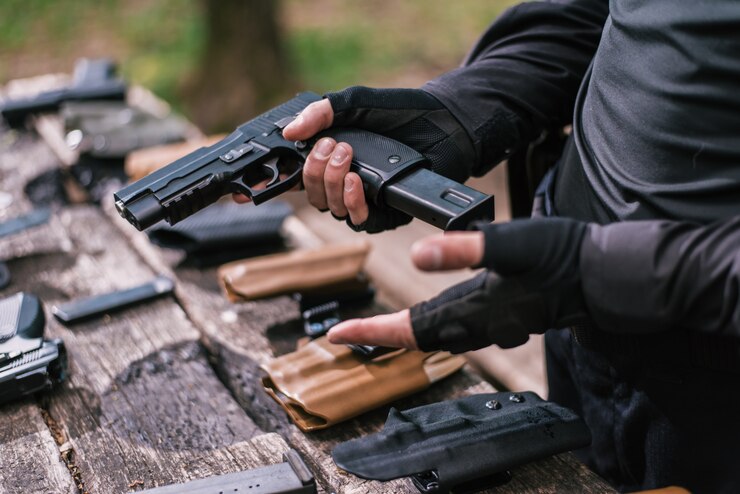In the world of handgun training, Maryland Handgun Qualification Courses (HQL) serve as an essential foundation for firearm safety, handling, and proficiency. While many beginners start with basic courses, those looking to refine their skills and elevate their shooting capabilities will benefit from advanced techniques that push beyond the basics. In this blog, we’ll explore some of these advanced techniques, providing insights into how they can enhance your skills in the Maryland Handgun Qualification and beyond.
1. Mastering Trigger Control
One of the most crucial aspects of shooting accuracy is trigger control. Proper trigger control ensures that your shots hit their intended target, reducing the risk of jerking the weapon or pulling off-target. In advanced handgun training, learning to squeeze the trigger rather than pulling it is key.
How to Perfect Trigger Control:
- Smooth Squeeze: Practice gently applying pressure to the trigger without jerking or flinching. This reduces muzzle movement during firing, leading to more accurate shots.
- Trigger Reset: After each shot, the trigger should be released slightly to the reset point before pulling it again. Learning the reset allows you to maintain control during rapid shooting.
Mastering trigger control will give you more consistent results on the range and in real-world scenarios, making it a vital part of your Maryland Handgun Qualification.
2. Understanding Stance and Grip
Your stance and grip form the foundation of your accuracy and control. In advanced handgun training, instructors will emphasize how minor adjustments can significantly affect shooting performance. The way you grip the firearm directly influences its recoil management, and your stance determines how effectively you can respond to various situations.
Proper Stance:
- Isosceles Stance: A strong, balanced stance with your feet shoulder-width apart and both arms extended towards the target provides stability. This is the foundation for consistent accuracy.
- Weaver Stance: This stance involves a slight lean forward with your dominant arm extended and your non-dominant arm bent. It’s effective for managing recoil and provides good target acquisition.
Proper Grip:
- High Grip: Keep the web of your hand high on the backstrap of the gun. This gives you more control over recoil and allows quicker follow-up shots.
- Firm, But Not Tense: Gripping the gun too tightly can cause tremors and inaccuracy. Instead, maintain a firm grip while ensuring you don’t lock your fingers or wrists.
By improving both your stance and grip, you’ll increase your accuracy and control, essential components in your journey towards mastering the Maryland Handgun Qualification.
3. Advanced Sight Alignment and Sight Picture
In the beginner stages of handgun training, shooters are taught the basics of sight alignment (lining up the front and rear sights) and sight picture (how you visually acquire the target). As you advance in your training, these skills must be refined further. Advanced techniques involve perfecting your ability to align the sights quickly and accurately, even under pressure.
Tips for Enhancing Your Sight Alignment:
- Focus on the Front Sight: While it’s natural to want to focus on the target, focusing on the front sight provides the clarity needed for precise shooting.
- Proper Sight Picture: A consistent sight picture is essential for hitting the target. Ensure the front sight is centered and level within the rear sight notch.
Refining your sight alignment and picture will help you deliver consistent accuracy in any situation. This is a fundamental skill in Maryland Handgun Qualification and is essential for more advanced shooting techniques.
4. Reloading Under Pressure
In advanced handgun training, reloading becomes a skill that’s honed under stress. During a high-intensity situation, you may need to reload quickly without losing focus or control. Practicing reloads is essential for any experienced shooter, as it allows you to maintain the flow of your shooting while minimizing downtime.
Reloading Techniques:
- Speed Reload: In a speed reload, you perform a quick magazine swap while keeping your eyes on the target. This technique can significantly improve response times during a firefight or competition.
- Tactical Reload: This technique is used when you have enough time to replace a partially used magazine to prevent running out of ammunition during an engagement. The tactical reload is slower but adds strategic value.
Both of these reloading techniques are critical in advancing your shooting abilities and improving your Maryland Handgun Qualification.
5. Shooting From Different Positions
Shooting from various positions can be especially useful in defensive situations, and practicing these skills is a must for advanced handgun training. While a standing position may be most common, situations may require you to shoot while kneeling, sitting, or even lying prone. The key is to adapt to your environment and remain effective in each position.
Practice These Positions:
- Kneeling: Kneeling reduces your profile and gives you a stable shooting platform. It’s also useful for protecting yourself from potential cover.
- Prone: Shooting from the prone position provides maximum stability. While it’s not often used in everyday self-defense situations, it can be valuable for long-range shots.
- Sitting: This position allows for quick response in tight situations where movement is limited.
Training in these different positions will make you more versatile as a shooter and better prepare you for real-world scenarios. Maryland Handgun Qualification includes instruction on basic stances, but mastering these advanced positions will take your shooting to the next level.
6. Improving Speed and Accuracy
An essential aspect of advanced handgun training is the balance between speed and accuracy. Beginners tend to focus on either one or the other, but experienced shooters know that achieving both simultaneously is crucial. The key is consistent practice and understanding that speed does not sacrifice accuracy if controlled properly.
Techniques for Improving Speed and Accuracy:
- Controlled Rapid Fire: Rather than firing as fast as possible, practice shooting rapidly while maintaining accuracy. Focus on keeping your shots in a tight group and your trigger squeeze smooth.
- Dot Torture Drills: This drill involves shooting at a series of small dots at varying distances and speeds. It’s designed to improve your precision while under time pressure.
By honing your ability to shoot both quickly and accurately, you will elevate your Maryland Handgun Qualification to the next level, making you a more effective and confident shooter.
Building mental resilience will give you an edge in any scenario, improving both your accuracy and your confidence.
Sign Up Here to Take Your Skills to the Next Level
Whether you’re looking to enhance your skills for personal defense, competition, or simply as a dedicated hobbyist, advanced techniques in handgun training are crucial. If you’re ready to take the next step in your Maryland Handgun Qualification journey, sign up here for an advanced class today. Don’t wait — elevate your training and experience.
For more information on advanced handgun techniques or to enroll in our upcoming courses, contact us. Our expert instructors are eager to help you refine your skills and achieve your full potential. If you’re serious about mastering your Maryland Handgun Qualification, go right here to begin your advanced training.









